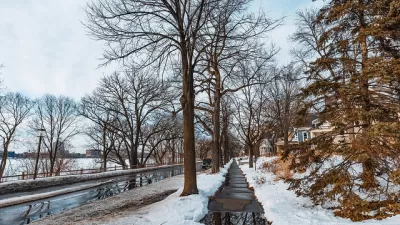Americans are living longer and changing the demographic profiles of our cities in the process. Planners are just beginning to understand how our streets and systems must adapt to accommodate this trend.
Did you know that crosswalks timers assume that people walk at about 4 feet per second? Most 80-year-olds don't move at that pace; just one illustration of why most places are "woefully unprepared" for an aging America.
"As Richard Florida reminded us last week, 10,000 baby boomers will turn 65 every day between now and 2031," notes Emily Badger. "By then, one in five people living in America will be older than 65. Crosswalks are only one piece of a deep-rooted problem composed of many subtle environmental details most of us never even notice: Is there a park bench to catch your breath? How about a curb cut for your walker?"
"Cities everywhere need to begin recalibrating for this moment now (a better crosswalk speed, for instance, would be closer to 3 feet per second)," she explains. "But this generational age bomb is also arriving at precisely the worst moment to pay for those changes that will actually cost money. And then there is the problem of imagination: How do you get urban planners, transportation engineers, and anyone running around a city in their prime to picture the places where we live through the shaded eyes of an octogenarian?"
"Age-proofing cities will be a cultural challenge as much as an urban design one."
FULL STORY: The Next Big Infrastructure Crisis? Age-Proofing Our Streets

Alabama: Trump Terminates Settlements for Black Communities Harmed By Raw Sewage
Trump deemed the landmark civil rights agreement “illegal DEI and environmental justice policy.”

Study: Maui’s Plan to Convert Vacation Rentals to Long-Term Housing Could Cause Nearly $1 Billion Economic Loss
The plan would reduce visitor accommodation by 25% resulting in 1,900 jobs lost.

Why Should We Subsidize Public Transportation?
Many public transit agencies face financial stress due to rising costs, declining fare revenue, and declining subsidies. Transit advocates must provide a strong business case for increasing public transit funding.

Wind Energy on the Rise Despite Federal Policy Reversal
The Trump administration is revoking federal support for renewable energy, but demand for new projects continues unabated.

Passengers Flock to Caltrain After Electrification
The new electric trains are running faster and more reliably, leading to strong ridership growth on the Bay Area rail system.

Texas Churches Rally Behind ‘Yes in God’s Back Yard’ Legislation
Religious leaders want the state to reduce zoning regulations to streamline leasing church-owned land to housing developers.
Urban Design for Planners 1: Software Tools
This six-course series explores essential urban design concepts using open source software and equips planners with the tools they need to participate fully in the urban design process.
Planning for Universal Design
Learn the tools for implementing Universal Design in planning regulations.
Caltrans
Smith Gee Studio
Institute for Housing and Urban Development Studies (IHS)
City of Grandview
Harvard GSD Executive Education
Toledo-Lucas County Plan Commissions
Salt Lake City
NYU Wagner Graduate School of Public Service





























